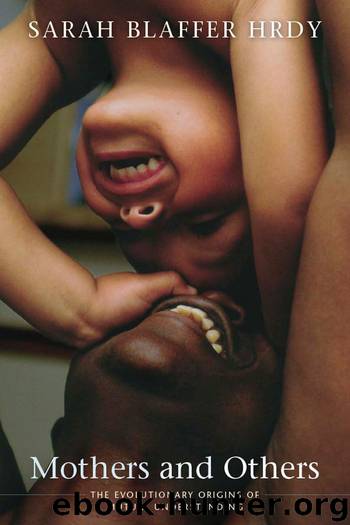Mothers and Others by Sarah Blaffer Hrdy

Author:Sarah Blaffer Hrdy [Hrdy, Sarah Blaffer]
Language: eng
Format: epub
ISBN: 9780674032996
Publisher: Harvard University Press
Published: 2011-04-14T22:00:00+00:00
Among some of the infant-sharing primates where allomaternal care of infants is beneficial to their mothers and where infants are in competition with other infants born around the same time to attract this care, neonatal coats have evolved to be more than just distinctive; they are positively flamboyant, visible to would-be caregivers from far away. But since birds of prey, often the biggest predators upon arboreal monkeys, have excellent color vision, flamboyant natal coats are visible to them as well. From high above the forest, these raptors can also pick up the message “New baby on board,” suggesting that the advantages to infants from being desirable commodities must have been great enough to outweigh this extra risk.
Within the far-flung subfamily Colobinae, infant-sharing species across Africa, Asia, Southeast Asia, Borneo, and Sumatra have evolved a diverse wardrobe of natal coats. Ebony langurs from Java, dusky leaf monkeys from Malaya, and silver leaf monkeys from Borneo are all born bright orange, reflecting the sunlight like spun gold. Sumatran mitered leaf monkeys are born white with a dark stripe down the back crisscrossed by another stripe across the shoulders, while Bornean proboscis monkeys are born with robin’s-egg-blue faces and distinctive, upturned blue noses. African black-and-white colobus babies are born covered in snowy white fur. Are these monkeys really so different from the dowdy jeans-wearing parents in Harvard Square who squire about children wearing brightly colored designer outfits?
Locale to locale, Mother Nature had to make do with the genetic materials she had at hand, but wherever benefits outweighed the costs, natural selection favored the production of infants that advertised their status as really new babies, helping to ensure their care. Over the hundreds of thousands of years it took to evolve flamboyant natal coats, attracting allomothers must have been sufficiently important to parental reproductive success to make this a good bet despite the increased predation risks.
But wait, some primate-savvy reader might say. Given how especially important alloparents are to callitrichids, why is it that marmoset and tamarin infants arrive in the world dressed so much like their grown-up parents? Baby golden lion tamarins, for example, are born the same color as their parents, distinguished only by a contrasting black stripe down the middle of their forehead. Such drabness seems to challenge the hypothesis that reliance on shared care favors the evolution of fancy natal coats. Rather than brightly broadcasting their neonativity, babies whose survival will depend absolutely on allomaternal attention wear uniforms that blend discreetly into the fur of the adult to whose back they cling. One possible explanation is that marmoset babies do not have to compete for alloparental attentions as much, since ordinarily only one mother is producing at a time. Alternatively, such seeming anomalies may be reminders of the constraints past evolutionary history places on natural selection. Rather than devising the perfect solution in the most efficient possible way, Old Mother Nature had to make do with what she had on hand, the ingredients in her cupboard left over from previous creations, a matter of phylogeny.
Download
This site does not store any files on its server. We only index and link to content provided by other sites. Please contact the content providers to delete copyright contents if any and email us, we'll remove relevant links or contents immediately.
Rewire Your Anxious Brain by Catherine M. Pittman(18586)
Talking to Strangers by Malcolm Gladwell(13288)
The Art of Thinking Clearly by Rolf Dobelli(10315)
Mindhunter: Inside the FBI's Elite Serial Crime Unit by John E. Douglas & Mark Olshaker(9260)
Becoming Supernatural by Dr. Joe Dispenza(8165)
Change Your Questions, Change Your Life by Marilee Adams(7679)
Nudge - Improving Decisions about Health, Wealth, and Happiness by Thaler Sunstein(7655)
The Road Less Traveled by M. Scott Peck(7554)
The Lost Art of Listening by Michael P. Nichols(7452)
Mastermind: How to Think Like Sherlock Holmes by Maria Konnikova(7278)
Enlightenment Now: The Case for Reason, Science, Humanism, and Progress by Steven Pinker(7272)
Win Bigly by Scott Adams(7133)
The Way of Zen by Alan W. Watts(6548)
Daring Greatly by Brene Brown(6472)
Big Magic: Creative Living Beyond Fear by Elizabeth Gilbert(5675)
Grit by Angela Duckworth(5554)
Ego Is the Enemy by Ryan Holiday(5345)
Men In Love by Nancy Friday(5192)
The Laws of Human Nature by Robert Greene(5077)
